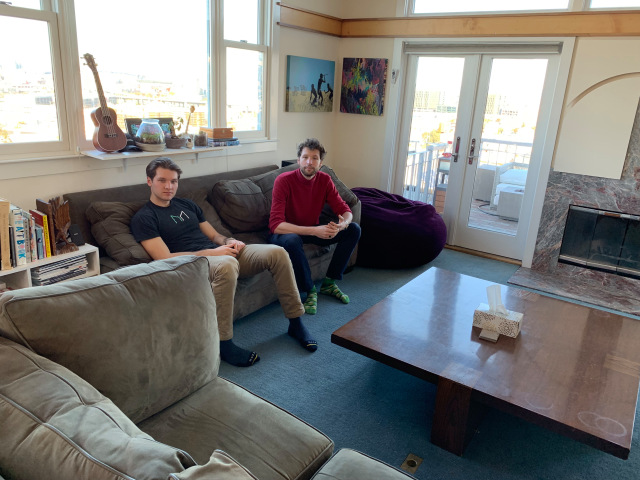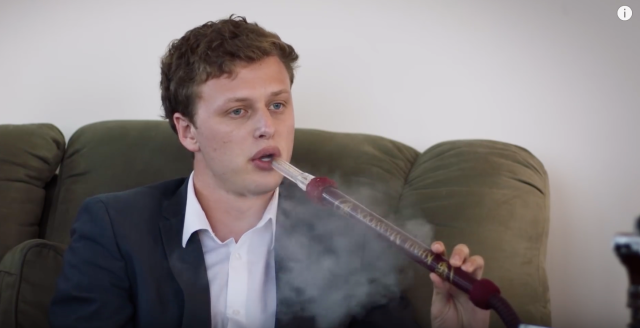When was the top? When was the peak of crypto fever? Maybe it was on Dec. 17, 2017, when the price of bitcoin came close, so tantalizingly close, to kissing $20,000? Or maybe it was the glut of magazine covers like Fortune’s “BLOCKCHAIN-MANIA!” Or maybe when a certain boxer announced, while shilling an ICO, “You can call me Floyd ‘Crypto’ Mayweather”?
These are all fine candidates, but the true apex of crypto-mania came on Jan. 13, 2018, when The New York Times published “Everyone is Getting Hilariously Rich and You’re Not.” Something of an instant classic, the piece found a concrete image—almost a face—for the young and cocky crypto-entrepreneur: the “Crypto Castle,” located in San Francisco.
The king of the castle, as The Times described him, was then-25-year-old Jeremy Gardner, a “rakish young investor with a hedge fund who has become the de facto tour guide for crypto newcomers.” The press was enthralled. Business Insider took us “Inside the Crypto Castle, where young bitcoin entrepreneurs party and plot the future of money.”
In the “Hilarious Rich” article, Gardner is “shaken” by the crazy-high price of bitcoin, the attention, and the sudden spotlight on the castle. Too much, too soon. “Nothing feels real, it doesn’t feel real,” he said at the time. “I’m ready for crypto assets to go down 90 percent. I’ll feel better then, I think. This has been too insane.”
Well. He got his wish.
Over the last year, the bulk of crypto assets have indeed gone down nearly 90 percent, the castle has faded from the headlines, and Gardner, who felt somewhat mischaracterized, took a moratorium doing interviews.
I was curious…where are they now?
What’s the Crypto Castle like in the darkness of Crypto Winter? Do people still live there? Are they hodling or “buidling”? Is ramen the new Lambo? I made a pilgrimage to the castle to find out.
The castle is located in the Potrero Hill neighborhood of San Francisco. It’s at the top of a steep hill, which left me out of breath, panting, when I arrived at the front door.
There’s no moat. No drawbridge. No trumpets that announce the king.
I ring the doorbell. The door swings open and I’m greeted by Aymard Dudok De Wit, a tall, lightly-bearded guy who speaks with a Swiss accent. As De Wit gives me a tour, two things are immediately clear: There are very few signs of crypto, and it looks nothing like a castle. It’s a normal three-story apartment. The garage is cluttered and contains a white-board and makeshift meeting room. (In this garage, an early resident of the castle, George Hotz, once built a self-driving car.) Outside is a small backyard with a lonely hammock; the hot-tub is sealed shut, a fitting metaphor for Crypto Winter.

“We’ve had around 100 people stay here in total,” says De Wit, as he politely shows me each bedroom and bathroom, almost like a real-estate agent. Roughly 80 percent of the inhabitants have been men, and it shows—framed Star Wars art, a Rick and Morty poster, and a jokey political sign of “Palin/Voldemort 2016—why settle for the lesser of two evils?” It’s surprisingly clean.
In one of the few visual nods to crypto culture, the fridge is coated with stickers like the bitcoin logo, “21 million,” “Fuck the FDA,” “Bernie 2016,” and one that says “Sorry We’re Dicks.” On top of the fridge are two large tubs of protein powder.
Get the BREAKERMAG newsletter, a weekly roundup of blockchain business and culture.
It’s late on a Tuesday afternoon. A few people are clacking on laptops or quietly taking calls. De Wit leads me to the heart of the castle, a spacious living room with a commanding view of the San Francisco skyline. We take a seat on the same leather couches where Ethereum wunderkind Vitalik Buterin once crashed. To the hardcore crypto faithful, perhaps this room is hallowed ground, a Mecca, like the garage in Los Altos where Jobs and Wozniak built the first Apple.
I had thought about bringing them a six-pack of beer, as it’s basically happy hour. That would have been a mistake. “Can I get you a juice?” asks De Wit, and he hands me an “Honest Kids” juice box—the kind you puncture with a tiny straw. I accept and it’s surprisingly tasty. “None of us are really big drinkers.”
De Wit has lived in the castle since the summer of 2017, or “just after burning man.” (The Venn diagram of crypto and Burning Man looks like the Venn diagram between LA bartenders and LA screenwriters.) He’s been lurking in the Bay Area crypto space since the early days of Coinbase meet-ups, when Brian Armstrong still showed up in person, hustling, to give one quarter of a bitcoin to anyone who opened a Coinbase account. The quarter bitcoin was worth around $20 at the time, or about $1,000 at the time of this article’s publication.
“Why do you like living here?” I ask De Wit.
Orest Byskosh and Aymard Dudok De Wit

“The location,” he says. “It’s close to the airport, and it’s also close to Whole Foods.” He’s sort of joking but sort of not. He then gives his real answer: It’s nice to have a community of like-minded people, a buffet of stimulating conversations, and a “place where I feel at home.”
There’s a baby-faced guy on the other couch. He’s focused on his laptop and he would, it’s quite clear, rather be working than chatting with a journalist. (No one I talked to seemed media-hungry.) Yet he gamely plays along. This is Orest Byskosh, a soft-spoken crypto-entrepreneur who looks a bit like a surfer. (He does surf, but he says “not well.”) Byskosh was 11, or “maybe 12,” when he first heard of bitcoin, and he started investing as a teenager. “In high school I spent a lot of my time on the exchanges,” he says, literally trading bitcoin in the middle of class. “In school there’s a lot of time where you don’t have to pay any attention,” he explains.
Is everyone still getting hilariously rich, while we’re not? This is a touchy subject. Like the rest of the castle-dwellers, Byskosh is uncomfortable talking about money or crypto-wealth.
When he was 12 years old, Byskosh urged his father to put money into bitcoin, when the price was $1. His father eventually listened to him and invested…just before the price hit $1,000. During the ICO boom he invested in about 30 or 40 ICOs. “Most of them aren’t around anymore,” he acknowledges, but the ones that did work out, like Golem, gave a “decent return.” In total, he says he started with a few hundred dollars, and that the return is “north of 150X.” Now he’s Head of Research at Ausum Ventures (pronounced “awesome”), the crypto-fund from Jeremy Gardner, the founder of the castle.
Byskosh is 20 years old.
Is everyone still getting hilariously rich, while we’re not? This is a touchy subject. Like the rest of the castle-dwellers, Byskosh is uncomfortable talking about money or crypto-wealth. Gardner once said that there were at least six people who became millionaires while residents of the castle, but in general, they insist that they’re focused on the work, the tech, and the projects, just as professional athletes insist that they’re “taking it one game at a time.” There’s no display of wealth, no icky flaunting. “There’s a high chance that people do have a lot of money here, but no one tends to show it,” says Byskosh.
“Just look at our couches,” says De Wit.
But wait, what about the parties? What about the Wolf of Wall Street-style benders, complete with coke and quaaludes and strippers?
I ask De Wit about the party scene. He gets up from the couch and flicks on an LED lighting system that runs along the top of each wall, encircling the room. It blinks and flashes. This looks sad and desolate in mid-afternoon, like Reno during the daytime. “People think that we party more, and work less, than we actually do,” says De Wit.
For the dirt on the parties, I’m told I need to talk to Jeremy Gardner.
In 2015, Jeremy Gardner, who was working on one of the first dapps on the Ethereum network, simply needed a cheap place for him and his team to crash. “The house came out of necessity,” he tells me over the phone. “We couldn’t find investors. The entire team was living on a thousand dollars a month. We were building an incredibly bootstrapped project that everyone said would fail.”
That project was Augur. The (sometimes controversial) prediction market became one of the first eye-popping ICOs, raising $5 million. Theoretically that’s enough money to get nicer digs, but Gardner wasn’t ready to leave the crowded Crypto Castle. “I came to appreciate what the house meant to me,” he says, emphasizing the sense of community, the conversations, and a shared pride in working on stuff that matters.
There’s a reason Gardner can’t meet me in San Francisco. He’s in Miami, where he lives during the winter, and where, more to the point, he’s launching a new project: the Miami Crypto Castle. The new location, he explains, is “more like a castle—a 5-bedroom mansion on the water, with jet skis.” He acknowledges that in San Francisco, “if you’re a crypto-nerd, you want to check it out,” but that, realistically, it’s somewhat lacking in sex appeal. The Miami pad is designed to be a hotspot for DJs, influencers, models, and Instagram stars. “People want to come here [to the Miami Crypto Castle] because it’s a really cool place, and I’m able to draw in these really influential people.”
Why Miami? The short answer: Venezuela. The longer answer: “Latin America is the region most likely to be impacted by blockchain,” says Gardner, explaining that it has both the infrastructure (internet, electricity) and the need (hyperinflation, weak governments). Gardner views Miami as a gateway to Latin America, and the Crypto Castle is his gateway to Miami’s influencers.
During Art Basel, for example, one model-blogger chronicled her experience at the Crypto Castle yacht party, which was “complete with all the fixings of a millennial dream boat: weed, feed, booze, beats, and beautiful brunettes!” Photos on the blog show bikini-clad models cavorting on the yacht and pool floats, like unused footage of the Fyre Festival ad.
Photo courtesy Caitlyn Rose

How does the partying fit into Gardner’s interest in blockchain? Cozying up with the DJs and the Instagram stars, or “cultivating relationships,” as he describes it, accomplishes dual objectives: 1) spreading the word of blockchain (or, at times, marketing a particular crypto-project), and 2) recruiting investors with deep pockets. Stars have money. “In the 20th century, fame was enough for people,” Gardner says. But then the celebrities realized that “there’s a difference between rapper money and Zuckerberg money.” So the rappers invested. Gardner notes that 50 Cent, Dre, and P-Diddy became “incredibly wealthy not through music, but through things like venture capital, angel investing, and being a brand ambassador.” It takes more than just fame to create “generational wealth,” says Gardner, and that even now, in Crypto Winter, bitcoin is “part of the zeitgeist” and that these celebrities are interested in it. That’s his in.
“I’ve never been a fan of full-blown evangelism,” he says. “I’ve never been the type of person to force someone to download a bitcoin wallet, and then give them a bit of bitcoin to show how great it is. I don’t think that works.”
“There are so many DJs who love to invest in the stock market,” he says. “I tell them about Augur. And now these DJs are on Instagram talking about the prediction markets.” (I can see the logic. And I’m sure it’s a work in progress, but a search for #Augur on Instagram fetched something less than A-lister results.) He clarifies that he never gives the influencers a hard-sell, as that’s an instant turn-off. “I’ve never been a fan of full-blown evangelism,” he says. “I’ve never been the type of person to force someone to download a bitcoin wallet, and then give them a bit of bitcoin to show how great it is. I don’t think that works.”
Parties at the Crypto Castle tend to be ad hoc. “I’m a big believer in improvisation,” Gardner explains, as this keeps the expectations low. He prefers barbecues and pre-gaming to late-night ragers. “Someone super famous is not going to come to a big organized party.” More his speed: In San Francisco he knew a guy who trained NFL players, so he invited him to a low-key barbecue at the Crypto Castle, and the trainer “brought a bunch of 49ers, and they wanted to learn about crypto.”
Since he was a music promoter in college, Gardner is the rare person who’s fluent in both nerd-tech and cool-club-kid. So he gives the influencers a space to hang out and “just shoot the shit about life.” The trick to mingling with this world? “Don’t be a fanboy. Treat everyone exactly the same, whether it’s a homeless person or even Donald Trump.”
He pauses, reconsiders. “Although if I met Donald Trump I’d probably troll him.”
What’s an average Tuesday like at the San Francisco Crypto Castle? Byskosh wakes up at 7 a.m., hits the gym (and presumably pounds a protein shake), conducts calls with start-ups until noon, then does some research, then more research. “In the evenings I’ll read heavier material, like longer white papers,” he says. Then maybe some Apex Legends or Call of Duty. Then he does more reading before bed. The lifestyle feels more like “Everyone is Getting Hilariously Well-Researched, and You’re Not.”
As I’m chatting with Byskosh and Gardner, another roommate shuffles into the living room. This is Hans Pizzinini, 28, from northern Italy, an entrepreneur who came to the U.S. for a hardware project unrelated to blockchain (those still exist!)—involving a kind of shoe that “harvests energy” from your steps. (I’m still fuzzy on the details.) Last year he met Gardner and moved into the castle. “I was surrounded by guys talking about blockchain and crypto,” he says, and then—as so often happens—he fell in love with it. Pizzinini took a class on Solidity (a programming language for building on the Ethereum network), started attending BCH hackathons because why not, and now he’s launching a new blockchain project, shaforms.com , that aims to leverage machine learning to help lawyers review documents.
“So what makes you guys optimistic about blockchain?”

Suddenly they’re more engaged. The roommates have little interest in chatting about the parties or the money, but they perk up when we pivot to Sharding, Layer 2 solutions (“faster than Visa at a much cheaper rate; this will improve remittances”), decentralized computing (“no single point of failure”), and decentralized carbon credits (“it aligns incentives; if you lie, you lose the money.”)
Not everyone in the house is into crypto. Liz Toki, 25, is an interior decorator for a real-estate company. “There’s a lot of testosterone in this house,” she says, laughing. “I grew up with five brothers, so I’m used to it.” Toki manages the housekeeping and the rentals of a four bunk-bed room. Each bunk is $50 per night, or $250 per week, or $800 per month. And if you’re hoping to break gender stereotypes, look elsewhere. “Before I got here, oh, it was dirty. Clothes on the floor. Always drinks on the counter,” she says, and looks around the immaculate living room. “You should come when I’m not here. Then you’ll see.”
One thing Crypto Winter has changed, says De Witt, is how often he’s approached about investment advice. “My friends used to text me ‘How can I buy bitcoin?’ Now they text me, ‘Is bitcoin dead?’”

Adam McKay, the frat-turned-prestige director (Anchorman, Vice), produced a new docuseries on Amazon Prime, The Giant Beast That Is the Global Economy. The first scene of the first trailer is a conversation between two guys. One is the show’s host, Kal Penn. The other is Jeremy Gardner, and they’re sitting in the SF Crypto Castle.
In the scene, Gardner takes a long inhale from a pipe. “Do you smoke hookah?”
“Uh, no, I don’t,” says Penn.
On my second call to Gardner, I happened to catch him just as he had seen the clip for the first time. He’s still laughing in surprise. “I’m worried that depiction might not be flattering, but we’ll see,” he says.
This touches on the paradox of Gardner and the Crypto Castle. He admits that he has a reputation as the “Bitcoin Party Boy,” but insists that what he really cares about is the tech, the use cases, and the potential for social impact. To his credit, just as with the other guys, I can sense that he’d rather our conversation focus on things like, once again, the use of blockchain in Latin America. (People in crypto love talking about blockchain in Latin America.)
Related: When Hyperinflation Means You Can’t Buy Bread or Tylenol, Crypto Beckons
As I try to nudge Gardner back to fun and zany stories about the Crypto Castle—(I had visions of Gardner, Vitalik Buterin, and Elon Musk in a hot tub, dreaming about decentralization while getting soapy massages from models)—he ticks off the ways that crypto can help tame corruption, digitally store land titles, and help migrants by giving them a portable and trusted way to store value. “Trump has campaigned about the migrant caravans,” he says in his crypto-fast voice. “And he’s not wrong. There are millions of people. A diaspora leaving Venezuela with nothing but food on their back. What if you can give them a way to transport their wealth? That’s incredibly powerful.”
Gardner says he’s not seeking attention—and he reminds me that, for the past year, he has been on a press moratorium—but that his goal is to “capitalize on the zeitgeist of the 21st century while maintaining my integrity.” He’s refreshingly honest about his cynicism. “Am I happy with the state of society where the new gods are people with millions of followers on Instagram? No, not particularly. But it is the reality of the world.”

Another reality of the world, he has learned, is unwanted publicity. Gardner was disappointed by the earlier coverage. “The house has been broadly misrepresented,” he says. “It fits the narrative, and it gets clicks, and to a certain extent I can’t blame journalists for doing that, except when it’s disingenuous.” He calls the “Hilariously Rich” article “one of the lowest points of my career.” Gardner says that the journalist came over to the Crypto Castle for several hours, and they talked mostly about the underlying philosophy of cryptocurrency. “Never, in the course of the conversation, did we talk about my wealth. Never did we talk about making money,” he says, lamenting that a few months later, “I’m in this article being represented as this cocky party boy.” He pauses. “Which I most certainly am—she’s not wrong—but that’s not what our conversation was about.”
I have sympathy for both Gardner and the Times reporter. For context, the article was not a profile of Gardner or the Crypto Castle, but of the bonkers wealth of crypto millionaires. A well-rounded portrait of Gardner’s thoughts on blockchain philosophy was, arguably, out of scope. Still. I get where he’s coming from. And I also get that no one fits into just one box. A good friend of mine, for example, is a medical doctor who saves lives at a hospital during the day, and then, at night, he flits through the upper crust of New York City nightlife, equally comfortable discussing DJs and the latest study in the Annals of Internal Medicine.
Gardner seems to have accepted this Party-Boy-meets-Tech-Nerd persona, and even embraces it: The bio on his Instagram handle, @GonzoGardner, says that he’s “focused on the intersection of blockchain technology, social impact, and debauchery.” He also takes comfort in seeing how Elon Musk is treated by the media. “I think he’s the greatest living human,” Gardner tells me. “I understand now that if someone does anything that is new or questionable or radical, or makes any extreme or outlandish statements, they’re going to be depicted in these ways. I’m much more okay with it now.”
As our call winds down, through the phone, I can almost hear Gardner squirming at my questions about his “favorite memories” of the Crypto Castle. “Much more important than any sort of memory,” he says, “is that the castle represents the best of what crypto and blockchain technology can be. People getting together, trying to build great and meaningful projects and products, and not a focus on wealth.”
Then again… this is all sort of experimental, just like blockchain itself. “Frankly, I’d be lying to you if I told you there was some grand vision,” he says, laughing a bit. “There’s not.”
—
Jeff Wilser is the author of The Book of Joe: The Life, Wit, and (Sometimes Accidental) Wisdom of Joe Biden. All other photos by Jeff Wilser.